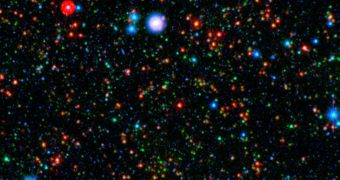Researchers at the American space agency have recently discovered a galaxy that they caught in the middle of its star-forming phase.
This is extremely rare, given that most of the galaxies astronomers have observed thus far are actually very old, and therefore produce only small amounts of new stars.
The team who made the recent finding say that the discovery is “the galactic equivalent of discovering pictures of a mild-mannered grandmother partying as a wild youth.”
The experts are based at the NASA Jet Propulsion Laboratory (JPL), in Pasadena, California. The new observations were carried out using the space agency's infrared Spitzer Space Telescope.
The observatory is one of the most sensitive instruments that the agency has in orbit, and it's especially suited for conducting scientific studies in the infrared portion of the electromagnetic spectrum.
Scientists found in the new Spitzer images that distant galaxies in the throes of stellar formation appears to create more new cosmic fireballs near their cores, and not at their edges.
This is precisely the opposite of what's going on in our part of the Universe, researchers say. In the Milky Way and surrounding galaxies, the areas around the central cores are nothing but graveyards, where no new stars are formed.
The new study was conducted by an international team of researchers, who were led by Texas A&M University in College Station expert Kim-Vy Tran.
The investigator says that this line of studies could in the near future give astronomers a better clue as to how very massive galaxies appear, develop and evolve.
Tran and her team analyzed the distant galaxy called LG J02182-05102 for about four months. This target was selected because it is located about 10 billion years away from our planet.
The galaxy also stood out due to its youthful appearance, as it was found to produce several thousands of new, blue stars each single year.
This incredible rate of stellar formation is much more elevated than anywhere else in the Milky Way, or in nearby galaxies.
“We have revealed the missing link between the active galaxies and the quiescent behemoths that live in the local universe,” Tran explains.
JPL, manages the Spitzer Space Telescope mission for NASA's Science Mission Directorate, in Washington, DC.

 14 DAY TRIAL //
14 DAY TRIAL //